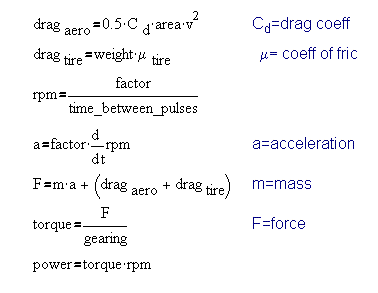|
|
|
|
From WEBSITE http://members.fortunecity.com/jasoncuadra/id47.htm
dynamometer
is a necessity for engine tuning work. I use a software dyno which I
wrote myself using Mathcad
and Matlab.
Absolute
accuracy is not needed for tuning, but consistency is. Here
is a plot showing the consistency of one run after another, and a comparison
against a Dynojet
run.
I got the
idea from Home
Dyno;
StreetDyno
is the same idea.
This is a
description of how it works:
A Dynojet
(they have a webpage somewhere) is a chassis dyno where your car is strapped
down, your tires turning against big heavy rollers. You let it idle in 2nd
gear or 3rd
gear, the
wheels turning slowly. Then you floor it, and the engine will accelerate the
rollers. There's a pickup that's clipped onto an ignition wire, which monitors
RPM. How fast
the rollers
accelerate is a function of the mass of the rollers and power delivered from
the wheels. The computer calculates then graphs torque and power.
The Home Dyno
is a software program, where instead of heavy rollers, your engine will
accelerate a known mass.. the car itself.
You do a 2nd
gear run on a flat road, starting around 1000 rpm (~15kph) to redline
(~90kph). No clutch slipping, no wheel spinning. That is, you start the car
moving in 1st,
then at 15kph
shift into 2nd, keeping it moving at a constant speed, then you floor it. A
timing light pickup is clipped onto a spark plug wire, and is connected to a
digital audio
recorder
(like a MiniDisc recorder or a HiFi video camera's mic input). The
"sound" the engine makes while accelerating is recorded into the
recorder. You then download the
sound into a
PC via the soundcard's mic input (it's turned into a .wav file), and process
it with the Home Dyno software. Voila, torque and power curves.
I wrote my
own version, for various reasons, using some math software that I use: Matlab
and MathCad. I used the signal in the Miata diagnostic connector ("IG"
pin) because it
is cleaner
and easier to process than a timing light pickup signal.
Here's a post
I did on a little bit on the nitty gritty details of my program:
Message:
3
Date: Mon, 16
Aug 1999 18:56:20 +0800
From:
JasonCuadra@xxxxxxxxxxx.xxx
Subject: Re:
Dyno runs
I did my own
version of "Home Dyno", for various reasons, with code that runs on
a special math package called "Matlab" + some processing in MathCad.
I found the pulse
detection,
data processing, smoothing functions, and equations pretty involved - it took
me a few weekends to get results I was happy with. The smoothing was the
hardest part.
Lots of
experimentation to see which worked best. The road has to be flat, and in my
experience a road that looks flat may not be.
If you use
the same road, and start at the same spot, consistency is pretty good -
subsequent readings are typically +/- 2%. I'm able to get torque measurements
down to 1000
rpm. +4hp
from a timing change was very very plain to see.
If the Link
gathers data every 0.2 second then the heavy smoothing required may affect
resolution. My program senses the location of every pulse from the diagnostic
connector
(every 180
deg crank rotation) and coincidentally the best smoothing compromise I found
was 0.2 sec. FWIW the best smoothing I found was "quadratic spline
interpolation"
provided in
MathCad.
Other things
to consider: 1% error in tire diameter is 2% error in readout, I assumed a
(stock) Cd of 0.38, and I assumed/calculated a rolling friction coefficient
from a coast
down time
from 50kph to 30kph (or something like that).
There is some
noise and jitter in the signal, even from the diagnostic connector, especially
in a J&S'ed Miata :-). Still much nicer than the signal from an inductive
timing light
pickup
though.
Cheers,
Jason
A mail from
Gary Morisson
Date: Sun, 15
Aug 1999 16:18:22 +1200
From:
"Gary Morrison" <teamvoodoo@xtra.co.nz>
Subject: Re:
Dyno runs
> I have
played with Home Dyno, and had a reasonably successful result. Jason
> Cuadra
has played with this and also with a program he wrote himself. He
> emailed
me output from that. In each case the calculation is based on rpm vs
> time and
takes account of vehicle weight, gear & diff ratios (use 2nd gear
> for home
dyno), temperature, aerodynamic drag etc. The homedyno output, and
that produced by Jason from my data, both were much the same as a
"real"
dyno.
Sequence
is:
Use software
PLL to read pulses - find pulse locations.
RPM is
inverse of pulse spacing
Extract RPM
vs. time
Smooth it a
bit.
Do a curve
fit using quadratic spline smoothing ("loess")
Convert RPM
to velocity (gearing)
Derivative of
velocity is acceleration

That's it.
|
| Copyright 1997-2006 Stephen Mullen, Oldsmar, FL -+- |